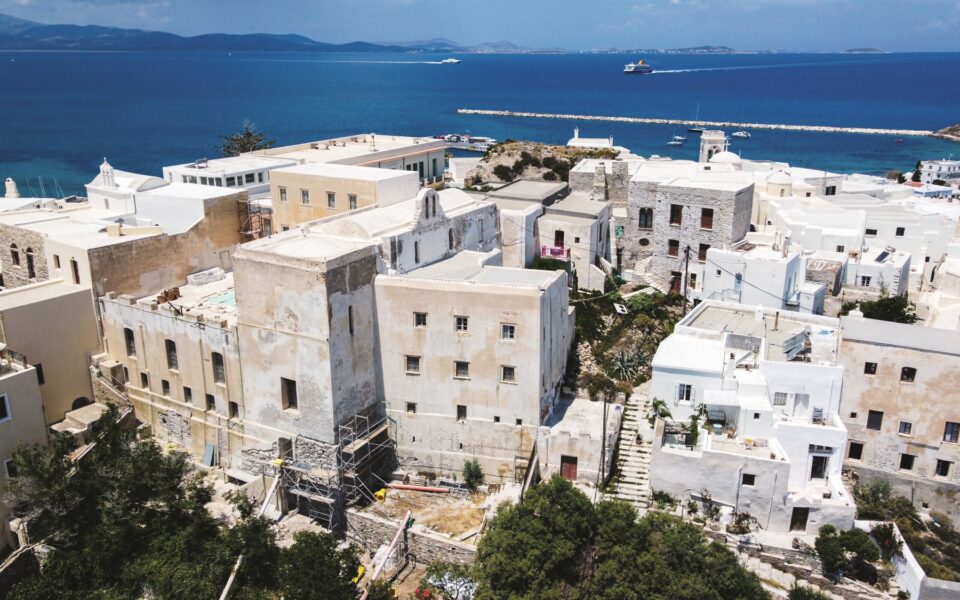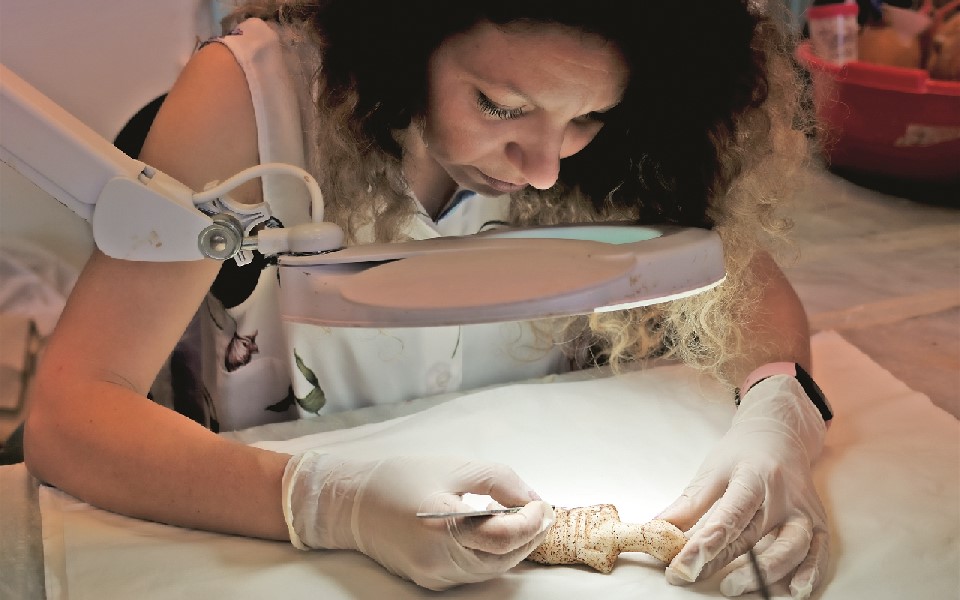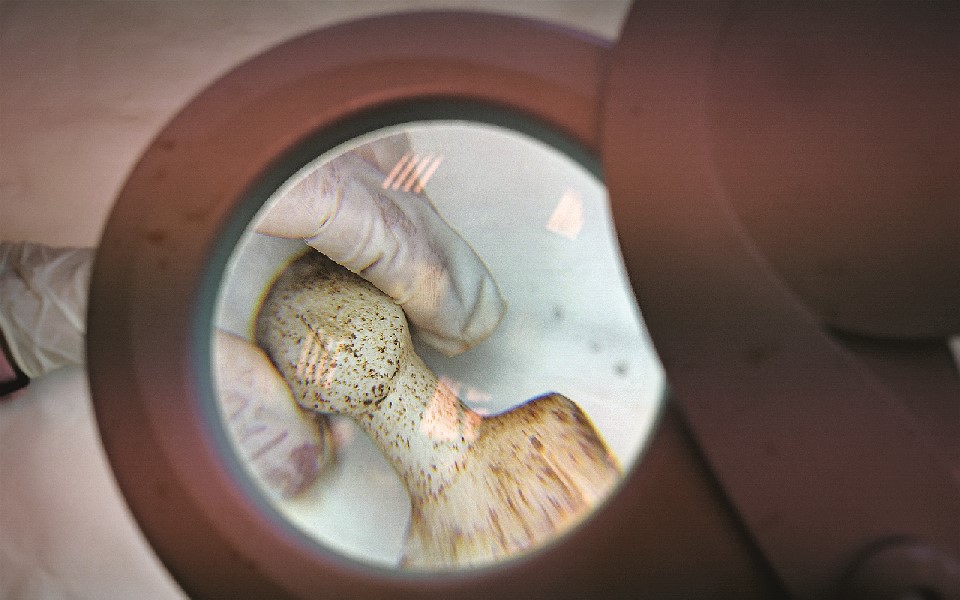A bowl full of lentils is the first thing that catches my eye among the tools and ancient ostracons (potsherds with writing scratched into them) on the worktable of antiquities conservator Marina Moustaka. I ask what they’re doing there and she tells me that lentils are the best way to store the delicate relics and that this particular bowl will be used for a Cycladic idol from the Steinhardt collection, which is being painstakingly cleaned in the lab of the Ephorate of Cycladic Antiquities.
The statuette of a female figure with folded arms is one of six artifacts that returned to their proper home a few weeks ago after being seized from the American billionaire Michael Steinhardt in 2021. The archaeologists, who received the relics from their interim stop at the National Archaeological Museum in Athens, were both awed and immensely relieved that they would finally be able to claim their place in the new Museum of Cycladic Culture that is being created on the island.
“The museum will host the largest number of Cycladic antiquities in the world,” says antiquities ephor (or curator) Demetris Athanasoulis as we make our way through the narrow, winding streets of Naxos’ medieval town to reach the castle (Kastro). The front is on the sea and the back is covered in scaffolding as the walls undergo repairs.
As we ride the elevator in the Catholic Monastery of Ursuline – which has a lovely café – Athanasoulis tells us about the origins of the Venetian castle, which he says dates to Byzantium, since the walls were built in the 7th century using ancient materials. The Venetians added a church and residences, many of which are still lived in today, creating a mishmash of eras, cultures and uses.
This is one of the castle’s very special characteristics that the distinguished archaeologist wants to showcase with the creation of a cluster of museums dedicated to the civilizations of the Cyclades, from prehistoric times to the Middle Ages, a project worth 8.3 million euros that is being carried out with European Union and regional funding.
“We are creating three new museums inside another museum, because the castle is a showpiece all by itself. By doing so, we want to make the castle an intrinsic part of the local community again. A new museum outside the city would have been cut off from the community,” says Athanasoulis.

© Konstantinos Georgopoulos
Athanasoulis takes us up and down staircases, through old wooden doors, past huge sacks of construction materials and tools, through crypts and out onto openings with incredible views of the Aegean Sea. He takes us to dusty chambers where he shows us sections of church domes and murals that will grace the Museum of Byzantine Naxos. We walk through the temporary archaeological exhibition and see the small but important Martinos collection that has been donated to the new museum, as well as the unique Cycladic pieces that will go on show, before entering the old archaeological museum, which looks like a proper construction site. Work on the exteriors and interiors is being carried out simultaneously so the museums can all be delivered to the public within the next four years, with some halls being ready to welcome guests sooner than others, according to the archaeologist.
But how are the practical questions of accessibility for people with disabilities and signposting, for example, going to be handled at a site where only basic interventions are permitted?
This is the conundrum for renowned architect Stelios Kois and his team, who are responsible for designing all three museums and their exhibitions. The central idea, which is still being developed in cooperation with the experts at the ephorate, is to strengthen the visitor experience without making interventions that are too obvious. “I like creating spaces that leave you with a certain feeling. There won’t be a third presence in the room with what I am planning,” he tells Kathimerini over the telephone.
Emery, which has been used on Naxos for centuries to grind flour and sharpen knives, is one of the key materials in the design, serving as a thread that starts in the bowels of the earth and connects the museums by appearing in different forms on the floors and in the spaces, which will be almost fully accessible for wheelchair users.
Natural sunlight will be used as much as possible to highlight the exhibits, while the element of water will also be showcased, though not in the usual way, stresses Kois. “We are interested in the sound, the reflection and the image of water,” he explains.
The main entrance to the three museums will be the Great Gate and from there, visitors will be invited to follow whatever path they want in a journey of discovery.

© Konstantinos Georgopoulos
Unfinished statues
The marble that was used to sculpt the famed statues of “kouroi” (youths) in ancient times was quarried on Naxos. The island was like a big marble workshop back then, which is why there are still some unfinished statues lying, as if asleep, deep in the hinterland, subject to the wear of the elements and the whims of visitors.
The Cycladic statues lay buried for centuries before they were brought to light by archaeologists or looters seeking to supply the international black market with antiquities.
“The relationship between the Cycladic civilization and contemporary art was both a blessing and a curse, as the association earned it popularity but also, ultimately, the looting of Cycladic antiquities,” says Athanasoulis.
The widespread looting of the Cycladic islands is something that the museum will underscore with a special section on the subject. “We will also be looking at the issue of antiquities theft through the prism of the relationship between the idols and 20th century art,” says the archaeologist. Exhibits will include the pieces from the Steinhardt collection and antiquities that have been seized in the past, but there will also be allusions to those that are expected to be returned.
“The Culture Ministry’s stated policy is that products of looting that belong to the Cycladic civilization but have no known provenance be brought to Naxos, whether they have been seized or returned,” he says, noting that in this framework, we can also expect the same treatment for the Stern collection of Cycladic idols.
In partnership with the Metropolitan Museum of New York, the Naxos museum will include a research center on the Cycladic civilization so that “orphan” antiquities can be studied and given an identity that will comprise, possibly, where, by whom and for what purpose they were made, as well as what happened to them.
“It is important for the Cyclades to have a specialized museum so that Greece can claim the return of its Cycladic antiquities, in the same way as the Acropolis Museum was created for the reunification of the Parthenon Sculptures,” says Athanasoulis.
Until this research center is created, the female idol with the crossed arms will remain snugly ensconced in the lentils until she finds her family – until then, at least she knows that she has come home.
This article was previously published at ekathimerini.com.












